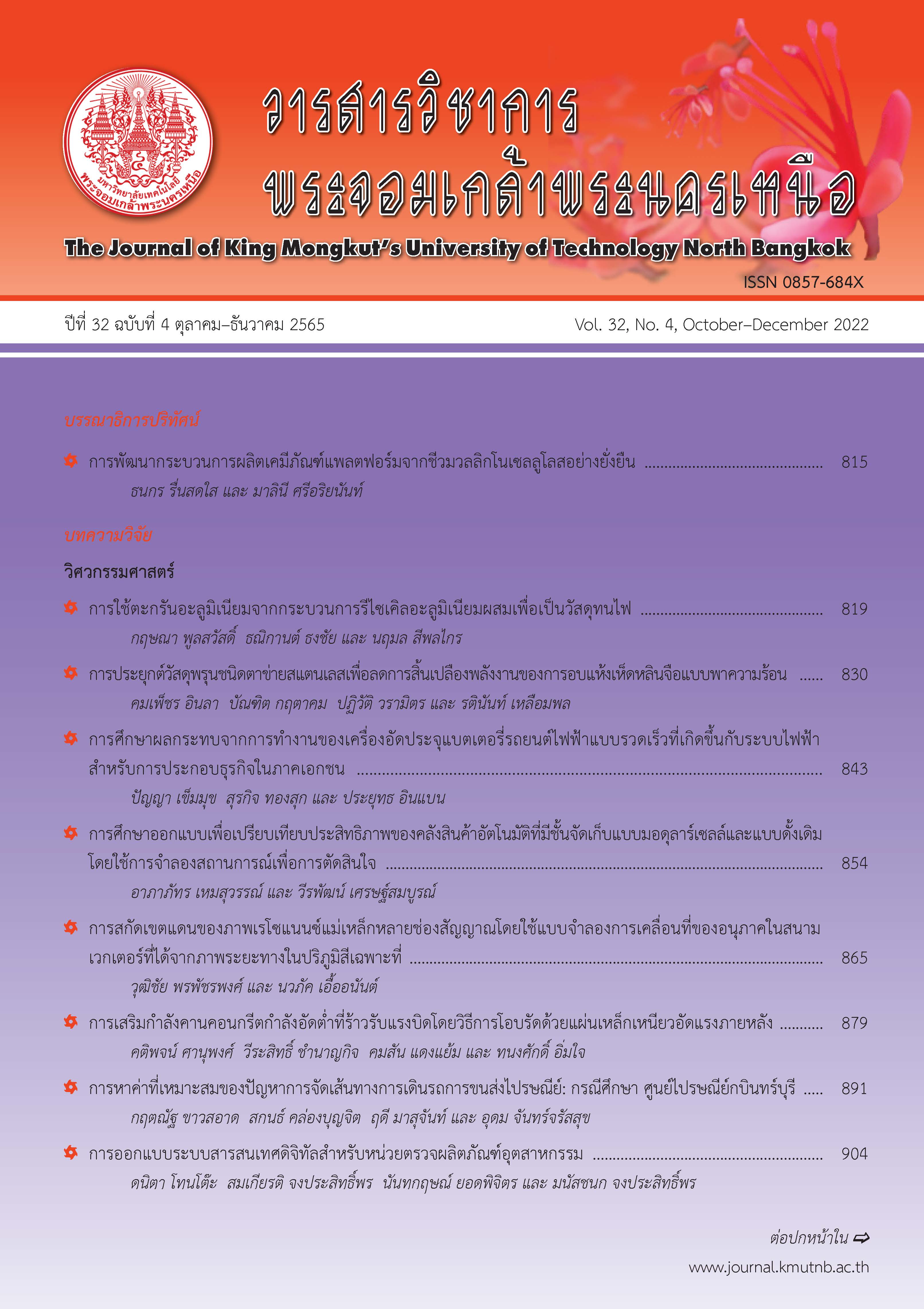The Impact Study of Electric Vehicle Quick Charger to Electrical System for Business in Private Sector
Main Article Content
Abstract
This paper presents the study of electric vehicle quick charger impact on electrical system for private business sector. The purposes of this study are: 1) to prepare guidelines for private entrepreneurs interested in installing a multi-standard quick charger to service EV and 2) to inform private entrepreneurs about the electrical effect from the operation of the electric vehicle battery charger. This presents by measuring the electrical quantity of the electrical system samples equipped with a practical multi-standard fast electric vehicle battery charger as well as other electrical parameters of the electric vehicle battery charger. This study analyzes the effects on the power system by measuring the parameters of the installed EV multi-standard quick charger consisting of 3-phase input voltage, 3-phase input current, input power, state of charge (%SOC), total voltage harmonic distortion (THDv), total current harmonic distortion (THDi), frequency (f), and power factor (p.f.). From the study, the various electrical parameters follow the standards of the Electricity Authority with the following parameters: the system phase-to-phase average voltage of 395.25 V, phase average voltage of 228.20 V, average voltage waveform distortion of 0.16%, average current waveform distortion of 0.51%, the average system frequency of 50.03 Hz, and the average power factor of the charger of 0.99. The results of the study show that there is no effect on the grid system during the operation of a number of standard fast electric vehicle battery chargers. In addition, there is no effect on the power distribution system or nearby users or connected appliances receiving power from the same transformer. The results of the study can be used to guide private entrepreneurs to be assured with installing a multi-standard quick charger to service EV resulting in encouraging the use of EVs in the country.
Article Details

This work is licensed under a Creative Commons Attribution-NonCommercial-NoDerivatives 4.0 International License.
The articles published are the opinion of the author only. The author is responsible for any legal consequences. That may arise from that article.
References
Energy policy and planning office, “Energy efficiency plan; EEP 2015,” Ministry of Energy, Chatuchak, Bangkok, Rep. EEP2015, 2015 (in Thai).
S. Siengchin, T. Boonyasopon, C. Tongprasit, P. Boonyasopon, K. Piboon, T. Roopsing, and S. Wisuttipaet, “Feasibility of electric bus implementation for long-distance public transportation,” The Journal of KMUTNB, vol. 27, no. 4, pp. 855–870, 2017 (in Thai).
EV charging station guide, 1st ed., Energy Regulatory Commission, Pathumwan, Bangkok, 2018 (in Thai).
EV charging station handbook, 1st ed., Energy Regulatory Commission, Pathumwan, Bangkok, 2018. (in Thai).
Energy Mahanakhon Co. Ltd. (2020, August). EA Anywhere Charging Station [Online]. Available: https://www.eaanywhere.com/maps
Metropolitan Electricity Authority. (2020, August). MEA Station [Online]. Available: https://www.google.com/maps/search/MEA +Station/@13.7416546,100.3959281,10.39z/ data=!4m3!2m2!5m1!4e9
Provincial Electricity Authority. (2020, August). PEA Station [Online]. Available: https://www. google.com/maps/search/PEA+Station/@13.6 87246,99.8867003,9z/data=!3m1!4b1
U. Prasanna, A. Singh, and K. Rajashekara, “Novel bidirectional single-phase single-stage isolated AC–DC converter with PFC for charging of electric vehicles,” IEEE Transactions on Transportation Electrification, vol. 3, no. 3, pp. 536–544, 2017.
G. R. C. Mouli, J. Kaptein, P. Bauer, and M. Zeman, “Implementation of dynamic charging and V2G using Chademo and CCS/Combo DC charging standard,” presented at the 2016 IEEE Transportation Electrification Conference and Expo (ITEC), Dearborn, MI, USA, June 27–29, 2016,
Plugs, Socket-outlets, Vehicle Connectors and Vehicle Inlets (Conductive Charging of Electric Vehicles - Part 3: Dimensional Compatibility and Interchangeability Requirements for Dedicated D.C. and Combined A.C./D.C. Pin and Contact-tube Vehicle Couplers), IEC62196-3, 2014.
M. C. Falvo, D. SbordoneI, S. Bayram, and M. Devetsikiotis, “EV charging stations and modes: International standards,” in Proceedings 2014 International Symposium on Power Electronics, Electrical Drives, Automation and Motion (SPEEDAM 2014), 2014, pp. 1134–1139.
Electric Vehicle Charging Stations Technical Installation Guide, 2nd ed., Hydro-Québec, Montreal, Canada, 2015.
Plug-In Electric Vehicle Handbook for Public Charging Station Hosts, 1st ed., The National Renewable Energy Laboratory (NREL), Golden, Colorado, United States, 2012.
Zach. (2015, September). Electric Car Charging 101-ypes of Charging, Charging Networks, APPS, & More!. [Online]. Available: https://evobsession. com/electric-car-charging-101-types-of-chargingapps- more/
Plugs, Socket-outlets, Vehicle Connectors and Vehicle Inlets (Conductive Charging of Electric Vehicles - Part 2: Dimensional Compatibility and Interchangeability Requirements for A.C. Pin and Contact-tube Accessories), IEC62196-2, 2016.
M. Bertoluzzo, G. Buja, and G. Pede, “Design considerations for fast AC battery chargers,” World Electric Vehicle Journal, vol. 6, no. 27, pp. 147–154, 2013.
P. Jumpeethong and S. Khomfoi, “An EV quick charger based on CHAdeMO standard with grid-support function,” in Proceedings 2015 18th International Conference on Electrical Machines and Systems (ICEMS 2015), 2015, pp. 531−536.
PEA Technical Standards, Technical Standards, 2016 (in Thai).
MEA Technical Standards,Technical Standards, 2015 (in Thai).

